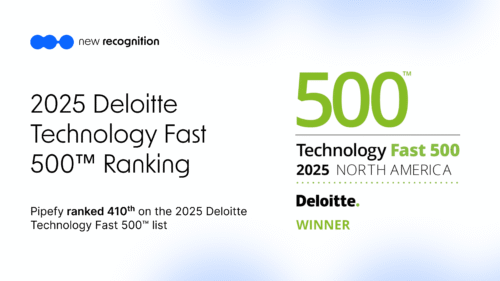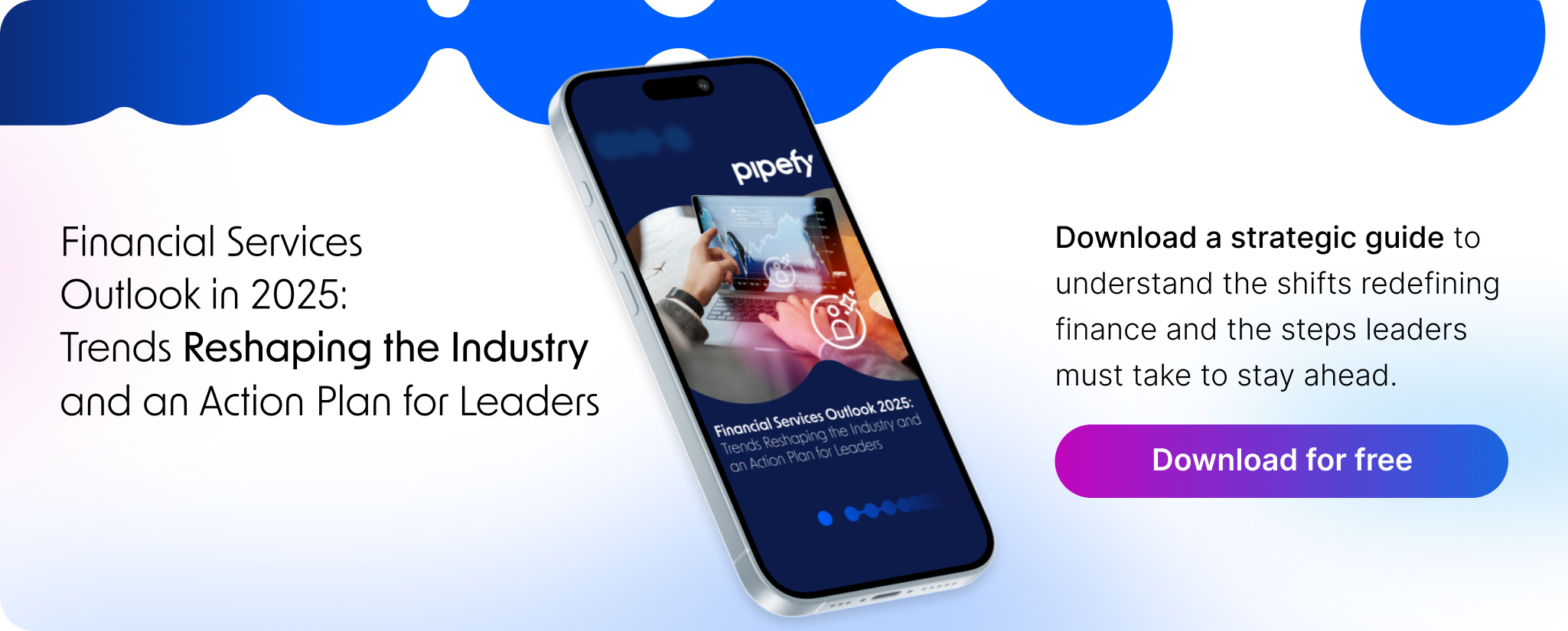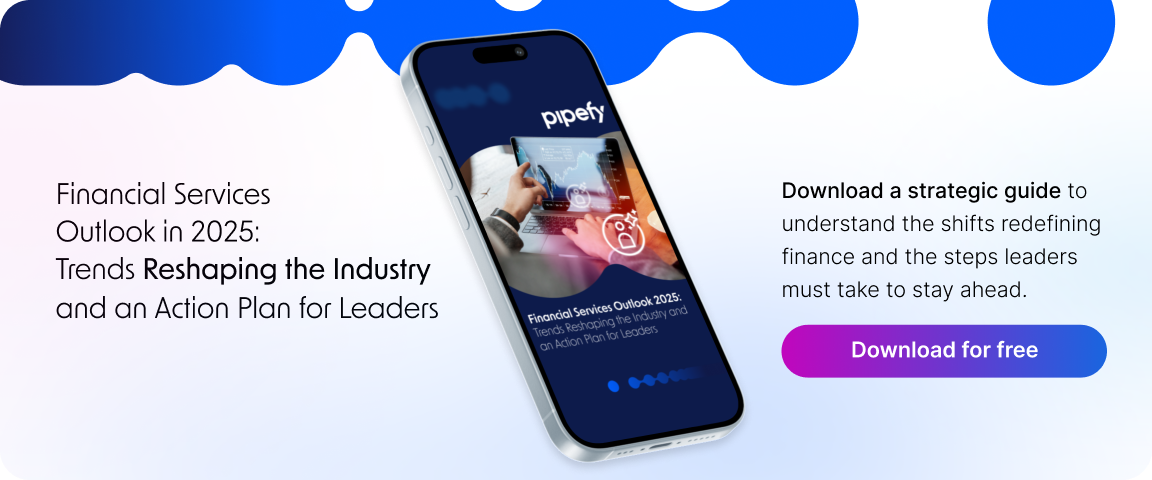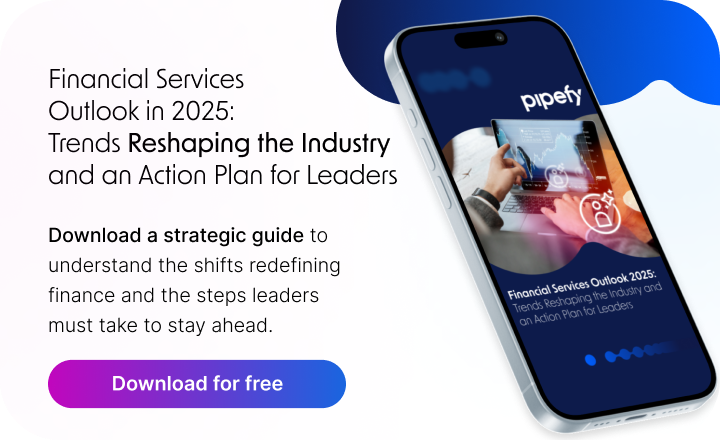
The measurable benefits of AI Agents are becoming clearer than ever, with this new technology promising to make business teams up to 66% more efficient while cutting operational costs by as much as 30%. This significant leap in productivity and savings is driving a profound wave of transformation across industries.
While the concept of Artificial Intelligence has been part of the business conversation for years, AI Agents represent a tangible evolution from simple automation to true operational autonomy and end-to-end orchestration.
The real shift is not AI Agents operating as isolated tools. The real value emerges when AI Agents are embedded into a business orchestration and automation platform. In Pipefy, AI Agents don’t operate in isolation: they live inside end-to-end orchestrated workflows, connecting systems, people, rules, and governance under a single control plane, delivering measurable ROI in days, not months and turning AI from experimentation into operational impact.
This article will move past the buzzwords to explore the concrete and measurable benefits of AI Agents. We will unpack what they are, how they differ from traditional tools, and the strategic advantages they offer to modern businesses. We’ll also examine practical applications and provide a clear picture of how you can use this technology to not just optimize processes, but to fundamentally reshape how your business operates and competes.
What Exactly Are AI Agents?
Before diving into the benefits, it’s crucial to understand what makes AI Agents a game-changer. Unlike traditional automation or basic AI models that follow predefined, rigid scripts, AI Agents are designed for autonomy. Think of them not as standalone tools, but as digital coworkers operating within governed workflows.
This autonomy allows them to handle complex, dynamic tasks that were previously handled exclusively by human employees. From screening job applications in Human Resources (HR) to managing a complete workflow and case management system for insurance claims, AI Agents are already tackling time-consuming back-office tasks, freeing up human talent to focus on more strategic, high-value work.
In essence, this is the core of Agentic AI: a software entity capable of perceiving context, making decisions, and executing actions. But in enterprise environments, true value only emerges when this autonomy is governed. That’s why AI Agents must operate within orchestrated workflows, where business rules, approvals, integrations, and auditability are built in by design.
This combination — AI Agents, end-to-end workflows, system integrations, and governance — is what enables organizations to move from task automation to reliable, enterprise-grade execution.
Read more: No-code AI Agents Development: Everything Your Company Needs to Know
The Market Confirms the Momentum
The strategic importance of AI Agents is not just a theoretical concept. It’s reflected in significant, measurable market growth and investment. The market is paying close attention, and for good reason. According to a report by Precedence Research, the Agentic AI space is projected to grow by nearly 50% annually, reaching a staggering market size of over $85 billion by 2034.
This explosive growth is a clear indicator of market confidence. It underscores that business leaders are no longer just experimenting with this technology but are actively integrating it into their core operations to achieve a sustainable competitive advantage. This trend signals that adopting AI Agents is quickly moving from an option for innovators to a necessity for any business serious about its long-term digital transformation.
From Simple Automation to True Autonomy: AI Agents vs. Traditional Tools
To fully appreciate the measurable benefits of AI Agents, it helps to compare them directly with more traditional automation technologies, such as Robotic Process Automation (RPA). While RPA has been valuable for automating repetitive, rule-based tasks, it operates within a much more limited framework and lacks the intelligence required for genuine end-to-end orchestration.
The following table highlights the key differences and showcases the evolution toward intelligent automation:
| Feature | Traditional Automation | Agentic AI |
| Task Scope | Executes simple, repetitive, and predefined tasks based on rigid rules | Manages complex, end-to-end processes that may involve multiple systems and dynamic variables |
| Decision-Making | Follows a strict “if-then” logic, cannot make independent decisions or handle exceptions | Possesses cognitive abilities to perceive, reason, and make autonomous decisions to achieve goals |
| Adaptability | Struggles with changes in processes or system interfaces, requires reprogramming for any deviation | Learns and adapts to new situations and changing environments in real-time without needing constant reprogramming |
| System Integration | Typically interacts with systems at the user interface (UI) level, mimicking human clicks | Integrates deeply with systems via APIs, enabling more robust and seamless cross-platform workflows |
| Human Supervision | Requires significant human oversight and intervention, especially for handling exceptions | Operates autonomously within governed workflows, with human-in-the-loop supervision for exceptions, approvals, and continuous improvement |
This shift from task-based execution to goal-oriented autonomy is fundamental. It empowers organizations to automate not just the simple steps but entire workflows, unlocking a new level of operational efficiency.
Read more: Explore the complete guide to streamlining your processes with AI Agent Automation
Sample Scenario: How a Financial Services Firm Could Leverage AI Agents
To make these concepts more concrete, let’s consider a hypothetical scenario. Imagine a mid-sized financial services company struggling with its client onboarding process. The workflow is manual, slow, and prone to errors. It involves multiple departments, from compliance to account management, leading to delays that negatively impact the client experience.
In a business orchestration and automation platform like Pipefy, this scenario would not rely on disconnected automations. AI Agents would operate inside a single, orchestrated workflow that connects compliance rules, core banking systems, human approvals, and customer communication, all with built-in governance and traceability.
Here’s how it might work:
Initial Data Intake and Validation
When a new client submits an application through an online portal, an AI Agent would immediately initiate the process. It could extract all relevant information, cross-reference it with internal and external databases to verify identity (Know Your Customer checks), and ensure all required documentation is present and correctly filled out.
Autonomous Risk Assessment & Case Management
Next, the agent could perform a preliminary risk assessment. By analyzing the client’s financial profile against predefined regulatory and internal policy rules, it might assign a risk score. This step showcases a key aspect of workflow and case management, where the agent categorizes and prepares the case for the next stage without human input.
Intelligent Document Routing
Based on the client type and risk score, the AI Agent would then intelligently route the application to the correct human teams. Low-risk, standard applications might be fast-tracked for automatic approval, while high-risk or complex cases would be escalated to senior compliance officers with a full summary and all relevant data already compiled.
Proactive Communication
Throughout the process, another AI Agent could be tasked with client communication. It might send automated, personalized email updates to the client at each milestone, informing them of the status of their application. This would improve transparency and reduce the number of inbound status inquiries.
In this fictional scenario, the implementation of AI Agents within the Pipefy platform would transform the company’s operational efficiency. These intelligent agents wouldn’t just automate steps; they’d orchestrate governed execution across systems and teams.
Most importantly, the human teams would be freed from these administrative tasks, allowing them to focus on building client relationships and managing complex financial strategies.
Key Applications of AI Agents Across Business Functions
The utility of AI Agents extends far beyond a single department. Their ability to handle complex processes makes them valuable across the entire organization. Here are just a few examples of how they are being applied in key business functions:
Finance and Procurement
- Automating the accounts payable process with full end-to-end orchestration, from invoice receipt and data extraction to validation and payment approval.
- Continuously monitoring supplier contracts for compliance, renewal dates, and performance metrics, flagging any deviations for human review.
Human Resources (HR)
- Screening thousands of job applications by using Agentic AI to match candidate qualifications against job requirements, shortlisting the most promising individuals.
- Managing the entire employee onboarding workflow, including sending documents, provisioning system access, and scheduling orientation sessions.
Customer Service
- Implementing an intelligent workflow and case management system where agents handle complex customer inquiries by accessing information from multiple systems (CRM, billing, knowledge base) to provide comprehensive answers.
- Proactively identifying at-risk customers by analyzing usage patterns and communication history, and then triggering retention workflows.
IT and Operations
- Monitoring IT infrastructure for performance issues, autonomously diagnosing problems, and executing remediation steps for common incidents.
- Managing inventory levels by tracking sales data and supply chain information, and then automatically generating purchase orders when stock is low.
In each of these areas, AI Agents act as force multipliers when combined with orchestrated workflows, deep integrations, and enterprise governance. This is the foundation of intelligent execution at scale.
Read more: Find out how to calculate the ROI of no-code automated processes
FAQ about the Benefits of AI Agents
As with any transformative technology, questions and misconceptions naturally arise. Let’s address some of the most common ones:
1. Are AI Agents the same as Generative AI?
Not exactly. While Agentic AI often uses large language models (LLMs) like Generative AI technologies, for understanding and communication, its core function is different.
While Generative AI excels at creating content (text, images), AI Agents, on the other hand, are built to take action and execute tasks across different software systems to achieve a goal. They are agents of action, not just generation.
2. Do AI Agents replace human jobs?
The more accurate way to view AI Agents is as collaborators that augment human capabilities. By automating repetitive and time-consuming tasks, they free up human employees to focus on strategic thinking, creative problem-solving, and complex interpersonal relationships, areas where human intelligence remains irreplaceable.
The goal is to enhance productivity and job satisfaction, not to replace people. This reflects a key aspect of the future of work, where humans and autonomous employees work side by side.
In mature enterprise environments, AI Agents operate with supervised collaboration models. Humans remain in control of approvals, exceptions, and strategic decisions, while agents handle execution. This human-in-the-loop approach is essential for trust, risk management, and long-term scalability.
3. How difficult is it to implement AI Agents in my business?
Historically, implementing advanced automation required extensive coding and specialized technical teams. However, the rise of no-code and low-code platforms is changing that.
In Pipefy, AI Agents are deployed as part of pre-orchestrated workflows. This drastically reduces implementation complexity and allows teams to achieve measurable results in days, not months, without long consulting projects or heavy custom code.
4. Can AI Agents scale to handle our growing business needs?
Absolutely. Scalability is one of the most significant advantages of using AI Agents. Unlike manual processes that require hiring and training more people to handle increased volume, AI Agents can be deployed or replicated almost instantly to manage a higher workload.
On a platform like Pipefy, this means your automated processes can scale seamlessly with your business growth, ensuring consistent performance and efficiency without a proportional increase in operational costs.
5. How can we ensure security and governance when using AI Agents with sensitive data?
Security and governance are fundamental when implementing any new technology. Leading platforms that offer AI Agent capabilities are built with enterprise-grade security protocols. This includes features like role-based access controls, detailed audit logs of every action an agent takes, and adherence to data privacy regulations.
You can set precise boundaries for what AI Agents can see and do, ensuring they operate strictly within your company’s governance policies and only interact with the data necessary to perform their tasks. This controlled environment is essential for using automation in regulated or data-sensitive industries.
In a business orchestration and automation platform like Pipefy, governance is not just a safeguard; it’s a competitive advantage. It enables organizations to scale AI safely, audit decisions end to end, and continuously improve execution without losing control.
How Pipefy Can Help You Harness the Power of AI Agents
Navigating the complexities of digital transformation requires more than just powerful technology, it demands a platform that makes that technology accessible, manageable, and scalable.
Pipefy acts as the orchestration layer between systems, people, and AI, combining no-code workflows, Agentic AI, deep integrations, and enterprise-grade governance to turn workflows into governed execution engines. By embedding AI Agents into end-to-end orchestrated processes, Pipefy enables organizations to move from AI experimentation to real operational impact, delivering AI results in days, not months.
By integrating powerful Agentic AI capabilities directly into its user-friendly environment, Pipefy helps your business automate entire workflows, manage complex workflow and case management scenarios, eliminate bottlenecks, and ensure seamless collaboration between human teams and their digital coworkers.
Click the button below to book a demonstration and discover how Pipefy’s solutions can help build the future of your business today:










